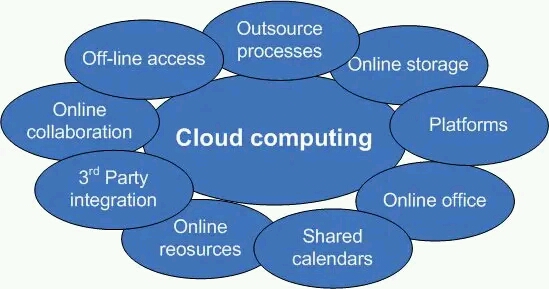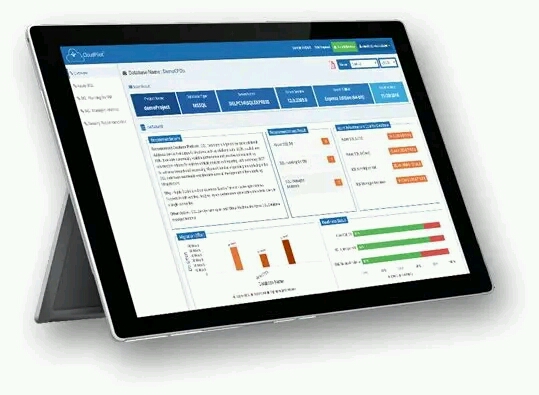Unleashing the Power of Cloud Computing

Unleashing the Power of Cloud Computing! ??
Are you ready to embark on a revolutionary journey into the world of cloud computing? ? Brace yourself as we uncover the myriad benefits, explore various cloud service providers, and delve into cutting-edge concepts like hybrid cloud, multi-cloud strategies, and serverless architecture. Get ready to soar high above the constraints of traditional infrastructure!

What is cloud computing?
Cloud computing refers to the delivery of computing resources and services over the internet. Instead of relying on local servers or personal devices to store and process data, cloud computing enables users to access and utilize a network of remote servers hosted on the internet. These servers are maintained by cloud service providers who offer various computing services, such as storage, processing power, databases, networking, and software applications.
Cloud computing provides several benefits to businesses and individuals. It allows for on-demand access to a wide range of resources, which can be easily scaled up or down based on the needs of the user. This scalability enables organizations to efficiently manage their computing infrastructure and accommodate fluctuations in demand, ensuring cost-effectiveness and optimal resource utilization.
Additionally, cloud computing offers increased flexibility and mobility. Users can access their data and applications from anywhere with an internet connection, using a variety of devices, including laptops, smartphones, and tablets. This accessibility promotes collaboration, remote work, and the ability to quickly respond to business requirements.
There are three primary service models in cloud computing:
Infrastructure as a Service (IaaS): This model provides virtualized computing resources such as virtual machines, storage, and networks. Users have control over the operating systems, applications, and configurations but are responsible for managing them.
Platform as a Service (PaaS): PaaS offers a complete development and deployment environment in the cloud. It provides the infrastructure and tools necessary for developers to build, test, and deploy applications without worrying about managing the underlying infrastructure.
Software as a Service (SaaS): SaaS delivers software applications over the internet on a subscription basis. Users can access and use these applications directly without the need for installation or management. Examples of SaaS include email services, customer relationship management (CRM) systems, and productivity tools.
Cloud computing provides a flexible, scalable, and cost-effective approach to utilizing computing resources and services, revolutionizing the way businesses and individuals manage and access their data and applications.
Unleashing the Power of Cloud Computing

? The Benefits of Cloud Computing: A Paradigm Shift
Imagine a world where you no longer worry about hardware maintenance, scalability, or data security. That’s precisely what cloud computing brings to the table. By leveraging the power of the cloud, you can experience:
1?? Flexibility and Scalability: Scale your resources up or down effortlessly, ensuring that your infrastructure matches your needs in real-time. With cloud computing, you can bid farewell to hardware limitations and embrace unlimited scalability.
2?? Cost Optimization: Traditional IT infrastructure often requires significant upfront investments, but cloud computing offers a pay-as-you-go model. You only pay for the resources you use, eliminating wasteful spending and reducing operational costs.
3?? Reliability and Disaster Recovery: Cloud service providers operate multiple data centers, ensuring redundancy and minimizing the risk of data loss. Automatic backups and disaster recovery mechanisms ensure your critical data is safe and sound.
4?? Collaboration and Accessibility: Cloud computing breaks down geographical barriers, allowing teams to collaborate seamlessly regardless of their physical location. Access your files, applications, and data from any device with an internet connection, empowering a truly mobile workforce.
Unleashing the Power of Cloud Computing

? Exploring Cloud Service Providers: A World of Options
When it comes to cloud service providers, the sky’s the limit! Here are a few leading names in the industry, each with its own unique offerings:
Different Cloud Service Provider
There are several prominent cloud service providers in the market. Here are some of the major ones:
Amazon Web Services (AWS): AWS is a comprehensive and widely-used cloud platform offering a vast array of services including computing power, storage, databases, analytics, networking, machine learning, and more.
Microsoft Azure: Azure is Microsoft’s cloud computing platform that provides a wide range of services and solutions for building, deploying, and managing applications and services. It offers capabilities for virtual machines, databases, AI, analytics, and more.
Google Cloud Platform (GCP): GCP is Google’s suite of cloud computing services. It provides infrastructure, storage, analytics, machine learning, and other services for building and running applications. Google’s expertise in search and data analytics is a key advantage of GCP.
IBM Cloud: IBM Cloud offers a range of infrastructure and platform services, including virtual servers, storage, databases, AI, and analytics. It focuses on providing enterprise-grade solutions with strong security and reliability.
Oracle Cloud: Oracle Cloud provides a comprehensive set of cloud services, including infrastructure, platform, and software as a service (IaaS, PaaS, and SaaS). It emphasizes its expertise in database management and offers various enterprise-oriented solutions.
Alibaba Cloud: Alibaba Cloud is the cloud computing arm of Alibaba Group, a leading Chinese e-commerce company. It offers a wide range of cloud services, including computing, storage, networking, databases, AI, and more, primarily targeting businesses in China and the Asia-Pacific region.
Salesforce: Salesforce is a cloud-based customer relationship management (CRM) platform. It provides solutions for sales, marketing, service, and other business functions. Salesforce also offers a platform for building custom applications and integrates with other cloud services.
VMware Cloud: VMware Cloud is a suite of cloud services offered by VMware. It combines VMware’s virtualization and software-defined data center technologies with cloud infrastructure, providing a hybrid cloud environment and seamless workload migration.
These are just a few examples, and there are other cloud service providers in the market as well. Each provider has its own unique set of services, pricing models, and target audiences, so it’s important to evaluate them based on your specific requirements and objectives before choosing one.
Unleashing the Power of Cloud Computing

? Unlocking the Potential: Hybrid Cloud and Multi-Cloud Strategies
Hybrid cloud and multi-cloud strategies are revolutionizing the way businesses architect their IT infrastructure. Here’s a glimpse into these groundbreaking concepts:
What Is Hybrid Cloud?
Hybrid cloud refers to a computing environment that combines the use of both public and private clouds, allowing organizations to leverage the benefits of both. It’s a strategic approach that enables businesses to maintain control over their sensitive data and applications on private infrastructure while also taking advantage of the scalability and cost-efficiency of public cloud services.
In a hybrid cloud setup, organizations typically have their own private cloud infrastructure, either on-premises or hosted in a dedicated data center. This private cloud is used to store and process sensitive or critical data that requires enhanced security, compliance, or specialized configurations.
At the same time, the organization can also utilize public cloud services, such as infrastructure as a service (IaaS), platform as a service (PaaS), or software as a service (SaaS), provided by cloud service providers like Amazon Web Services (AWS), Microsoft Azure, or Google Cloud. Public clouds offer vast computing resources, scalability, and a wide range of services that can be used to support various workloads and applications.
The hybrid cloud model allows organizations to seamlessly integrate and manage resources across both environments. It enables them to optimize their IT infrastructure by dynamically scaling resources based on demand, leveraging the public cloud for peak usage periods while maintaining critical data and applications in a private, controlled environment.
Furthermore, hybrid cloud deployments provide flexibility and enable workload portability. Organizations can choose where to deploy their applications and data based on factors such as performance requirements, cost considerations, data sensitivity, and regulatory compliance.
Hybrid cloud combines the advantages of private and public clouds, offering organizations greater flexibility, scalability, and control over their data and applications while leveraging the benefits of public cloud services.
What Is Multi-Cloud Strategy?
Multi-cloud strategy refers to an approach where an organization utilizes multiple cloud computing services from different cloud providers to meet their specific needs. Rather than relying on a single cloud provider, businesses leverage the capabilities of multiple cloud platforms simultaneously.
In a multi-cloud strategy, organizations distribute their workloads and applications across different cloud environments, such as public clouds (e.g., Amazon Web Services, Microsoft Azure, Google Cloud Platform) and private clouds (on-premises or hosted by third-party vendors). This approach enables businesses to take advantage of the unique features, services, and pricing models offered by each cloud provider.
Key components of a multi-cloud strategy include:
Flexibility and Vendor Independence: Multi-cloud allows organizations to avoid vendor lock-in by utilizing services from multiple providers. This flexibility provides the freedom to choose the most suitable cloud platform for each workload, application, or specific business requirement.
Risk Mitigation: By distributing workloads across different cloud providers, organizations can reduce the risk of service disruptions, data loss, or security breaches. If one cloud provider experiences an issue, the workload can be shifted to another provider, ensuring business continuity.
Optimization of Services and Costs: Different cloud providers offer various services and pricing models. By adopting a multi-cloud approach, organizations can optimize their infrastructure costs by selecting the most cost-effective services for each workload. Additionally, they can leverage specialized services from different providers to enhance functionality and performance.
Geographic Reach: Multi-cloud allows organizations to deploy their applications and services across different regions or data centers provided by various cloud providers. This geographic distribution helps improve performance, reduce latency, and comply with data sovereignty requirements.
Best-of-Breed Solutions: With a multi-cloud strategy, organizations can choose the best-of-breed solutions from different cloud providers. They can leverage the strengths and unique features of each platform to create a comprehensive and tailored infrastructure that aligns with their specific needs.
However, managing a multi-cloud environment can be complex. It requires expertise in integrating different cloud platforms, ensuring data portability and interoperability, managing security across multiple environments, and optimizing resource allocation. Proper governance and monitoring mechanisms are crucial to effectively manage a multi-cloud strategy.
Unleashing the Power of Cloud Computing

?? The Rise of Serverless Architecture:
What Is Serverless Architecture?
Serverless architecture, also known as Function as a Service (FaaS), is a cloud computing model where developers can build and run applications without the need to manage or provision servers. In traditional server-based architectures, developers have to manage the underlying infrastructure, such as servers, operating systems, and scaling capabilities. However, with serverless architecture, developers can focus solely on writing and deploying code while the cloud provider takes care of the rest.
In a serverless architecture, applications are broken down into smaller, independent functions that are deployed and executed in a stateless environment. These functions are event-driven, meaning they are triggered by specific events such as HTTP requests, database changes, file uploads, or scheduled tasks. When an event occurs, the cloud provider automatically provisions the necessary resources to execute the function, ensuring scalability and reliability.
SEE ALSO : Image Annotation In Machine Learning
One of the key benefits of serverless architecture is its ability to scale automatically based on the incoming workload. Developers don’t have to worry about provisioning additional servers or managing capacity as the cloud provider handles this automatically. This scalability is achieved by running functions in isolated containers and executing them on-demand.
Another advantage of serverless architecture is its cost efficiency. Since developers only pay for the actual execution time of their functions, rather than for idle server time, costs can be reduced, especially for applications with sporadic or unpredictable workloads.
SEE ALSO : How Artificial Intelligence Helps Businesses to Grow
Serverless architectures also promote modular and decoupled application design, as functions are typically designed to perform specific tasks and can be easily combined to create complex applications. This can result in increased development speed and flexibility.
SEE ALSO : The Advantages And Disadvantages of Cloud Computing
Popular cloud providers, such as Amazon Web Services (AWS) with AWS Lambda, Microsoft Azure with Azure Functions, and Google Cloud Platform with Cloud Functions, offer serverless computing platforms that support a variety of programming languages and integrations, making it easier for developers to adopt and leverage serverless architecture.
Comments are closed.